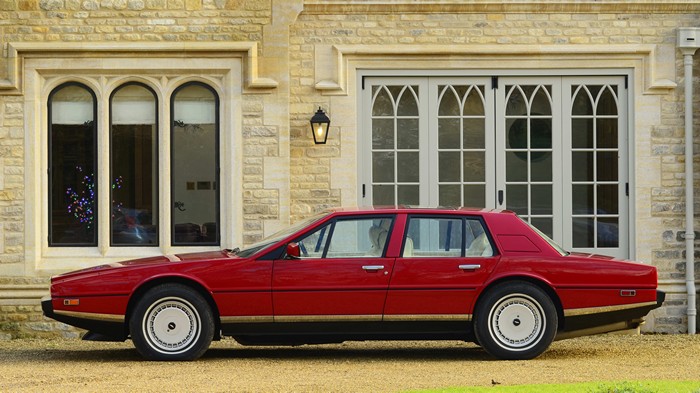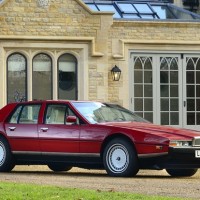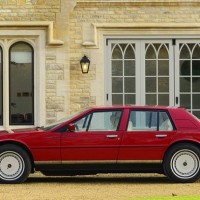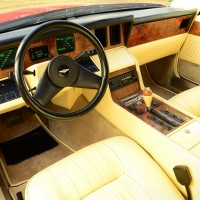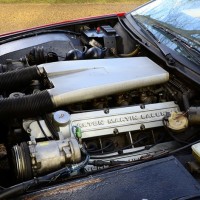SCM Analysis
Detailing
| Vehicle: | 1985 Aston Martin Lagonda sedan |
| Number Produced: | 645 |
| Original List Price: | $150,000 |
| Tune Up Cost: | $933. After that, anything goes |
| Engine Number Location: | Plate on right inner fender; engine number is stamped rear center top of block |
| Club Info: | Aston Martin Owners Club |
| Website: | http://www.amoc.org |
This car, Lot 625, sold for $37,387, including buyer’s premium, at Bonhams’ Paris Grand Palais Auction on February 7, 2013.
This legendary example of the classic “Beauty and the Beast” dichotomy was showcased at the Bonhams sale in Paris. Picture this: a 1985 Aston Martin Lagonda parked in the excessive elegance of the Grand Palais.
I guess our world puzzles me at times. I don’t understand the civilization-ending popularity of the Kardashians, the world’s current savage religious imbroglios, the true ingredients of haggis, why some golf balls spin and others don’t — or why anyone would insult their garage by parking a Suffolk Red Aston Martin Lagonda inside it. Any true, self-respecting, worn-out MG Midget, clapped-out Morris Minor or circus-color Citroën 2CV would commit suicide if forced to share a garage with the automotive anti-icon known as the Aston Martin Lagonda. Well, maybe these cars would quietly skulk away and find a place to rot in peace — and sabotage their own brakes for revenge on the owner.
The Grand Palais — a magnificent work of breathtaking architecture — was just sullied by this Ke$ha-mess of an automobile. Blech, just blech. I felt dirty just looking at it, and then I almost brushed up against it. Pop singer Ke$ha is having her pop-culture moment in much the same way this origami wedge did in the 1980s. Three, two, one and poof! If there’s any cosmic karma, Ke$ha will be relegated to the indignity of the “All-Time 10 Worst Pop Stars” — just like the Lagonda is placed on the “All-Time 10 Worst Cars” list each year.
If the steel girders in the Grand Palais could have come alive, they would have formed into a Transformers-like hand, punched a hole in the roof and thrown that pile of aluminum merde out to the Maginot Line in one swing.
Junk from a temple
My first visit to Aston Martin was 1985. It was old English cottage-industry craftsmanship at its finest. The body panel hammering was happily deafening, the one-technician engine building system artfully arcane and the smell of Connolly leather in the trim shop was curiously erotic. This Edwardian-era style of manufacturing produced the rather glorious, brutish and powerful V8 coupe, the Volantes, the Vantages — and the massive overreach known as the Lagonda.
With the Lagonda, Aston Martin was trying to build a space shuttle with technology from the Wright Brothers.
“We want to build a car with a 220-volt dashboard and mate it with a GM 3-speed slushbox and a glass sunroof that doesn’t actually open!” Do you see what I’m getting at? Reams of leather, pallets of burled wood, gallons of lacquer paint — all mated with electronics aching to leave the car where it was last parked.
This was the biggest car from stem to stern made with the smallest interior, a performance-neutering gearbox and ergonomics provided by Phineas and Ferb. No doubt Beauty and Beast were arguing in the boardroom.
Yes, Aston Martin sold 645 units, which may have bolstered the blood-red-ink bottom line during this production run. Yes, they catered to the newly wealthy, and yes, the Lagonda was considered “oh so modern and cutting edge” for five minutes. That’s it; that’s all you get. Crockett and Tubbs have aged better — and we don’t even know where Tubbs is!
I can’t believe that this stupendous absurdity of a car was built in a place that is still automotive hallowed ground. They were “Look at me because I’m famous, but I’ve never accomplished anything” cars. They are overweight, oddly shaped, slow — and don’t work most of the time. I knew the Kardashian thing would come full circle.
New owner needs luck, cash
In period, Aston Martin ran an ad that used the phrase “Demoralize Thy Neighbor.” Today, should you attempt to enjoy your newly purchased classic with any regularity, you will understand the phrase “Demoralize Your Wallet.” Folks, this is a warning. If you need proof, ask to see the wiring schematic for this car. You may as well buy a used Cray supercomputer to help write email and do Photoshop.
This transaction did have some merit, and there is a small silver lining to this sale. Kudos to Bonhams for placing this orphan. The car was Suffolk Red with Magnolia, which is sale-proof in most countries, and yet the car sold for the princely sum of $37,387.
Well sold, and bonne chance to the new owner. Hopefully he drove it away painlessly. You do know that at the world-wide launch the prototype failed to operate and had to be pushed? True story. ?
(Introductory description courtesy of Bonhams.)
